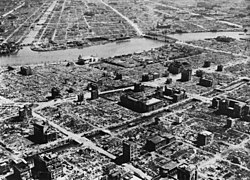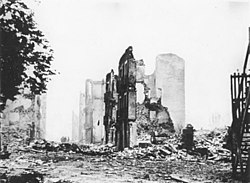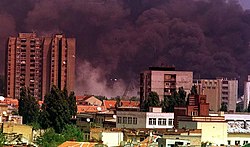Strategic bombing
Strategic bombing is a military strategy used to destroy the enemies' economic ability to fight a war. It is an attack from the air. Strategic bombing missions usually attack targets such as factories, railroads, oil refineries and cities. Missions would attack targets such as military bases, command and control facilities, airfields, and ammunition dumps.[1][2]
The United States Air Force (USAF) has used strategic bombers in later conflicts.
History
Strategic bombing was an idea first tried in World War I. It was used by the German Luftwaffe. They bombed Antwerp. Zeppelins were used to bomb England.
However, the strategic bombing in World War II was on a far larger scale than anything which went before. First, In the Battle of Britain the German Air Force almost defeated Britain by attacking the Royal Air Force planes on the ground. This was partly successful, and some think it was a mistake to switch to other targets. The British had primitive radar, good enough to know whereabouts each attack was going. There was time to get the fighters in the air to intercept and damage the attacks.
Despairing of victory this way, the attack was switched to the cities. German bombing of London and the larger provincial cities such as Coventry (an industrial city). They used high explosives and incendiary devices to cause fires.
Once the attacks on British air bases was diverted to the city targets, the Luftwaffe began to lose planes to the defences. The German air force, which had previously fought easy targets (for example, in the Spanish Civil War) began to take losses. Eventually these losses began to tell, and Hitler cancelled the planned invasion. He realised that no invasion across the Channel could succeed while Britain still had an active air force.
USA enters World War II
United States Army Air Force (USAAF) Colonel Billy Mitchell promoted strategic bombing in the United States. He had new ideas on the strategic, and tactical air war. The first USAAF strategic bomber was the B-17 Flying Fortress.
In the end, the large bomber fleets of the Allies devastated Nazi Germany with conventional bombs, and the atomic bomb was dropped on the Japan.
Later years
After World War II, the Strategic Air Command was located at Omaha, Nebraska, at Offutt Air Force Base. Nuclear weapons became an important mission.
A full cadre of generals at Offutt participated in many of the missions of the "Looking Glass", a KC-135 air tanker which was stripped and refitted with state of the art electronics which would take over in case the president was killed in wartime. The plane had several generals on board to assume wartime duties. The "red telephone" was an instant connection to the president at the White House. The plane flew all day every day, three planes took off a day in overlapping flights to provide this level of coverage. Since the end of the cold war, this flight ended, however, the Strategic Air Command still maintains the main facility at Offutt AFB - this is where President Bush flew to when the Twin Towers were bombed on 9-11-01 to set up his command center.
Strategic Bombing Media
Tokyo after the massive firebombing attack on the night of March 9–10, 1945, the single most destructive raid in military aviation history. The Tokyo firebombing cut the city's industrial productivity by half and killed around 100,000 civilians.
German airship bombing Calais on the night of 21–22 February 1915
Destroyed townhouses in Warsaw after the German Luftwaffe bombing of the city, September 1939
1943 USAAF raid on ball bearing works at Schweinfurt, Germany
A U.S. Air Force F-100C practices a nuclear bombing run.
Smoke in Novi Sad, Serbia after NATO bombardment
References
- ↑ Biddle, Tami Davis. 2004. Rhetoric and reality in air warfare: the evolution of British and American ideas about strategic bombing, 1914–1945. Princeton Studies in International History and Politics.
- ↑ Longmate, Norman 1983. The bombers: the RAF offensive against Germany 1939–1945. Hutchinson. ISBN 0-09-151580-7







